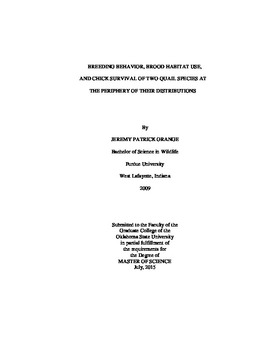| dc.contributor.advisor | Davis, Craig A. | |
| dc.contributor.author | Orange, Jeremy Patrick | |
| dc.date.accessioned | 2016-09-29T18:42:02Z | |
| dc.date.available | 2016-09-29T18:42:02Z | |
| dc.date.issued | 2015-07-01 | |
| dc.identifier.uri | https://hdl.handle.net/11244/45292 | |
| dc.description.abstract | One of the keys to understanding any species is acquiring a thorough knowledge of its breeding behavior and brood ecology. Until recently, little research has been conducted to understand the breeding behavior and brooding success of many quail species. As part of a larger study, I conducted research of sympatric northern bobwhite (Colinus virginianus) and scaled quail (Callipepla squamata) at Beaver River and Packsaddle wildlife management areas in western Oklahoma. Primary research objectives included: 1) investigate the survival, habitat use, and movement of northern bobwhite and scaled quail during the initial stages of their life and 2) to estimate rates of occurrence of alternative reproductive and brood-rearing strategies along with the mechanisms that may be influencing observed rates. As part of a larger project, adults were monitored daily during nesting and brood-rearing periods at two field sites in western Oklahoma to collect egg shells and feathers. Following hatching, I collected all hatched and unhatched eggshells. During capture of young chicks at 8�12 days old (chicks) and 4�6 weeks old (youths) for a survival study, I collected contour and down feathers. All samples were genotyped at a minimum of 10 species-specific microsatellite loci. Programs Colony and Genalex were used to investigate parentage and brood relatedness. During the 2013 and 2014 breeding seasons I genotyped samples from 56 nests (34 northern bobwhite and 22 scaled quail). Nest parasitism was documented in 7 (20.6%) bobwhite and 2 (9.1%) scaled quail nests. The percentage of total offspring resulting from extra-pair copulations was higher in bobwhite (29.3%) than in scaled quail (2.2%) nests. To better understand brood habitat use and chick survival, I also attached radio-transmitters to quail chicks and youths at capture. I found that the 20-day survival probability for chicks was higher in bobwhites (0.725 � 0.068) than in scaled quail (0.488 � 0.085), while the 35-day survival probability for youths was similar between bobwhite (0.788 � 0.086) and scaled quail (0.795 � 0.110). Microhabitat vegetation characteristics (angle of obstruction, shrub cover, and percent ground cover of 5 functional groups [grass, forb, legume, litter, and bare ground]) were also measured at brood locations. High levels of habitat partitioning were observed between species likely leading to observed differences in chick survival. I hope that information gained from this project will help researchers to gain an increased understanding of quail ecology. | |
| dc.format | application/pdf | |
| dc.language | en_US | |
| dc.rights | Copyright is held by the author who has granted the Oklahoma State University Library the non-exclusive right to share this material in its institutional repository. Contact Digital Library Services at lib-dls@okstate.edu or 405-744-9161 for the permission policy on the use, reproduction or distribution of this material. | |
| dc.title | Breeding Behavior, Brood Habitat Use, and Chick Survival of Two Quail Species at the Periphery of Their Distributions | |
| dc.type | text | |
| dc.contributor.committeeMember | Van Den Bussche, Ronald A. | |
| dc.contributor.committeeMember | Elmore, R. Dwayne | |
| dc.contributor.committeeMember | Leslie Jr., David M. | |
| osu.filename | Orange_okstate_0664M_14165.pdf | |
| osu.accesstype | Open Access | |
| dc.description.department | Natural Resources and Ecology Management | |
| dc.type.genre | Thesis | |
